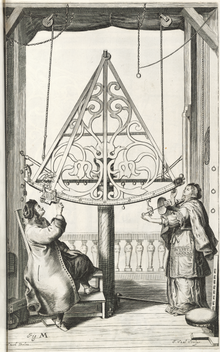Elisabeth Hevelius
Elisabeth Catherina Koopmann-Hevelius | |
|---|---|
 | |
| Born | 17 January 1647 Danzig, Poland |
| Died | 22 December 1693 (aged 46) |
| Occupation | Astronomer |
| Nationality | Polish |
| Partner | Johannes Hevelius |
Elisabeth Catherina Koopmann-Hevelius (Polish: Elżbieta Heweliusz; 17 January 1647 – 22 December 1693) is considered one of the first female astronomers. Originally from Danzig, Poland, she contributed to improve the work and observations done together with her husband Johannes Hevelius.
Early life
Elisabeth Koopmann was a member of a rich merchant family in the city of Danzig (modern-day Gdańsk, Poland), located in Pomeranian Voivodeship of the Polish–Lithuanian Commonwealth and a member of the trade organization called Hansa. Elisabetha Koopman's parents were Nicholas Koopman (1601–1672) who was a prosperous merchant and Joanna Mennings (or Menninx; 1602–1679).[1] Nicholas and Joanna were married in Amsterdam in 1633.[2] They moved from Amsterdam to Hamburg before moving to Danzig in 1636. It was in this city, largely German-speaking but a part of Poland at the time, that their daughter Elisabeth was born.[3]
Personal life


Elisabeth was fascinated with astronomy as a child. When she was sixteen, she married Johannes Hevelius, an astronomer of international repute who had a large complex of three houses in Danzig which contained a large observatory (over 200 square meters) equipped with several large telescopes.[4] Hevelius assisted her husband in the observatory as well as pursuing her own interests in astronomy.[5] They had a son, who died soon after birth, and three daughters who survived.[6] The eldest of the three daughters was named Catherina Elisabetha (after her mother) and baptized in St Catherine's Church, Danzig, on 14 February 1666.[citation needed]
Education
Elisabeth was self-taught in Latin and utilized her linguistic knowledge in intellectual exchanges with fellow scientists.[7] Her proficiency in Latin, a language widely used in scientific discourse during her time, facilitated meaningful communication and collaboration with peers.[8][7]
Her journey into the realm of Latin self-education underscores her profound dedication to the pursuit of scientific knowledge;[5] it highlights her proactive approach to not only comprehend scientific principles but also to actively participate in the discourse, thereby contributing to the collective pool of scientific understanding.[7] Elisabeth's language skills became a conduit for the exchange of ideas, fostering a collaborative environment in which she and her husband, Johannes Hevelius, could actively engage with the scientific community.[8]
Contributions to science
Elisabeth collaborated with her husband in study of astronomy and following her husband's death, she undertook the completion and publication of Prodromus astronomiae ('Elements of Astronomy') in 1690.[8][7][1] This catalog of stars documented the positions and relevant data for 1,564 stars.[7][4] Beyond being a significant advancement in celestial observation and recording, this work advanced the evolving landscape of astronomical knowledge during the 17th century.[5] Elisabeth's role in the Prodromus astronomiae extended beyond the conventional boundaries of data collection;[8] she emerged as an active participant in the complex calculations and methodologies inherent in producing a comprehensive star catalog.[7] Her contributions were quantitative and qualitative, signifying a meticulous and systematic approach to astronomical research.[8]
The collaborative efforts of Elisabeth and Johannes Hevelius in observing the celestial realm were marked by the use of advanced astronomical instruments.[8][9] Their observatory in Danzig became a hub of innovation, where they employed sophisticated tools such as brass sextants and octants.[9] These instruments played a significant role in refining observational techniques of the 17th century.[8] Through their adept use, the couple contributed significantly to the evolution of astronomical methodology, enabling precise measurements and observations that propelled the understanding of celestial bodies to new heights.[9]
In culture
Elisabeth's life was dramatized in the German language historical novel Die Sternjägerin ('The Star Huntress', 2006).[10]
The minor planet 12625 Koopman is named in her honor, as is the crater Corpman on Venus.[citation needed]
Notes
- ^ a b Hargittai, Magdolna (14 June 2023). Meeting the Challenge: Top Women in Science. Oxford University PressNew York. doi:10.1093/oso/9780197574751.001.0001. ISBN 978-0-19-757475-1.
- ^ Nicolaes Koopman x Johanna Mennincx, 13 october 1633, Stadsarchief Amsterdam, both from Hamburg ('van Hamborgh')
- ^ Hockey, Thomas (2009). The Biographical Encyclopedia of Astronomers. Springer Publishing. ISBN 978-0-387-31022-0. Retrieved 22 August 2012.
- ^ a b Januszajtis, Andrzej (2011). "A Walk Around Gdańsk for Physicists". Physics in Perspective. 13 (4): 456–480. Bibcode:2011PhP....13..456J. doi:10.1007/s00016-011-0066-5. ISSN 1422-6944.
- ^ a b c Stories of Women Stargazers, Dora Musielak, March 30, 2009
- ^ Gotthilf Löschin: Geschichte Danzigs von der ältesten bis zur neuesten Zeit: mit beständiger Rücksicht auf Cultur der Sitten, Wissenschaften, Künste, Gewerbe und Handelszweige, Volume 1, 1828 [1]
- ^ a b c d e f Reser, Anna; Mceill, Leila (2021). Forces of nature; the women who changed science. London: Frances Lincoln. ISBN 9780711248977.
- ^ a b c d e f g Gelbart, Nina. "Adjusting the Lens: Locating Early Modern Women of Science". Early Modern Women.
- ^ a b c Vertesi, Janet (2010). "Instrument Images: The Visual Rhetoric of Self-Presentation in Hevelius's Machina Coelestis". The British Journal for the History of Science. 43 (2): 209–243. doi:10.1017/S0007087410000440.
- ^ Eric Walz, Die Sternjägerin. Blanvalet Taschenbuch Verlag. 2006. ISBN 3442365236.
References
- Ogilvie, Marilyn Bailey. "Hevelius, Elisabetha Koopman". In: Women in Science, The MIT Press, 1986, p. 99 ISBN 0-262-15031-X (Short encyclopedia article)
- Walz, E. 2006. The Star Huntress. Random House/Bertelsmann. ISBN 978-3-442-36523-4 (Historical novel)
